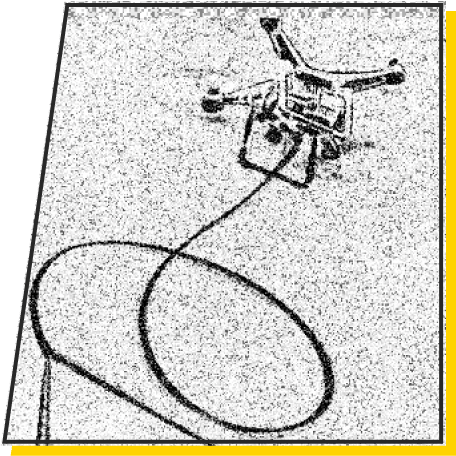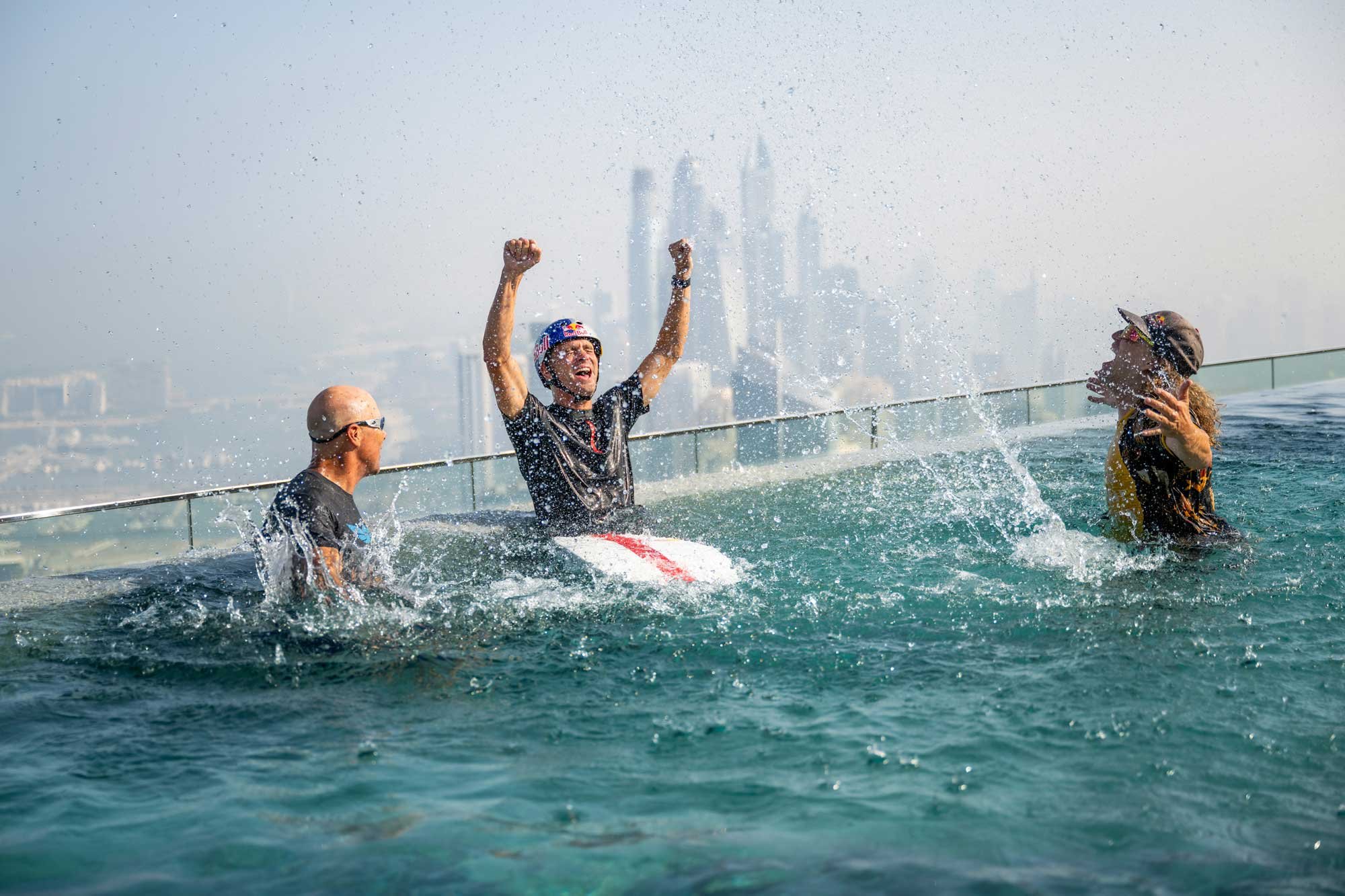
Watch the
eye-popping
video



The vision for WakeBASE grew in Brian’s mind for nearly a decade before it was developed and visualized in these initial sketches. The dream?
Even for someone who’s no stranger to finding innovative ways to push the boundaries of his sport, combining wakeskating, BASE jumping, and futuristic drone technology was raising the bar like never before.
�
Read on for a breakdown of how the dream became reality.
The dream
Altitude
964ft
Wind Speed
20kph
Brian Grubb:
a wakeskate visionary
Brian Grubb’s a pioneer that’s been pushing wakeskating to new heights all his career. His creativity, passion, and skill have been evident at some epic adventures all around the world.


The idea of being able to put these two sports together and take them to new places was the ultimate appeal. No one had ever done it before so to push my limits like this was exciting.�
Watch Brian in action

Snow in Bosnia





Slovenia Alpine River



eFoil at �Bluespring Caverns



Volcanic Valley in Jordan



step by step








01
Preparation
03
Countdown
04
Top speed
07
Freefall
05
Kicker
08
Landing
06
Detachment
02
Activation
Click on each step to learn more

Dubai
Location


Designing and building a drone powerful enough to pull a human athlete was taking a step into the unknown. To make it happen, Brian again collaborated with his friend Sebastian Stare who had developed the drone for the Slovenian project.
The bespoke human flying machine is unlike any other drone in the world and features unique software and hardware components that allow it to be extensively tuned to Brian’s needs.
�Sebastian said: “It’s somewhere between a standard DJI drone and a helicopter. Whenever it starts, I think everybody around gets goosebumps because it sounds pretty scary.
Pushing
boundaries
Lift Weight
55kg
Hover time
35min
Maximum incline
45°
Pulling time
15min



Brian left no stone unturned in preparing for WakeBASE. Training was all-encompassing and the project team were relentless in their pursuit of absolute perfection.
Click on each location and let Brian guide you through every training camp.
People see the final project on social media but there's so much that goes into it. The whole process has been one of the best experiences of my whole life.”
the
scenes
Behind







Germany


Switzerland
USA


03
Brian communicates with the drone pilot and gives the “three, two, one” countdown. The drone accelerates forward adding tension to the tether and as it starts to pull, Brian does a running start into the pool 964 ft above ground.
To land in the pool, I took three or four steps off the deck and put my board under my feet.


I started BASE jumping in 2020 and had done about 35 jumps before we started serious training. First, we went out to Idaho where Miles lives to jump the 486ft high Perrine Bridge. We had a great camp. It’s where we started working on the barrel rolls and some of the maneuvers we wanted to start doing.



The drone was operated by two pilots. One towing Brian, another backup pilot acting as a spotter.


WakeBASE

BASE jumping
Wakeskating
Here’s your explainer on how history was made at the world's tallest infinity pool in Dubai.
welcome to Brian Grubb’s WakeBASE






WakeBASE might have only lasted for 40 seconds but a lot of elements had to occur perfectly in that time to make it a success.
25kg
Weight
55KM/H
Top Speed
8
Motors
8
Propellers





A member of the Red Bull Air Force, Miles is a multiple world record holder who’s frequently pushed the boundaries of human aviation. His invaluable experience made him the perfect coach to prepare Brian for the BASE jumping part of WakeBASE.
I don't think we could have done the project without Miles. He taught me a lot. He made me feel really confident in my abilities so I was so lucky to have him train and mentor me."



Parks
Bonifay
training
Miles
Daisher
Parks is a legend of the wakeboarding scene and one of the most influential riders of all time. Friends since they were teenagers, Brian asked Parks for his expert opinion on how to keep the wakeskate connected to the rope and drone, and what trick to do off the kicker so he could get a clean exit off the building.
Parks has a great eye for setups like this. He really helped us look at the whole picture with the board and the tether. It was great to have his help getting the optimal performance from the drone to the board.
Brian Grubb
Brian Grubb

take
Using videos to watch yourself do the skills is super invaluable. We trained jumping off the cliffs together side by side, so I could get the aerial shots as he went.”
He’s a tremendous athlete and Brian’s the only person with enough training that could have pulled this whole thing off.”
Our goal was to make it look easy and that's not an easy thing because there were a lot of moving parts to the equation."
Miles'

take
Nothing about this was normal and it's probably one of the coolest projects that I've been a small part of.”
Brian’s like a master sensei of everything he does. He's very analytical and very strategic in the way he goes about things. He really ramped up his skills so he was mentally and physically prepared."
It was really critical that the wakeskate didn’t drop! It was an obstacle that we've never really had to deal with before."�
Parks'




next level drone tech
+
+

To develop a custom-built drone powerful enough to tow him




Ride behind it 964ft up in the air at the world’s highest infinity pool
Use the drone to launch him off a kicker from the 77th floor
BASE jump back to ground




2003
Career Start
Age
43
New Hampshire, USA
Born
He started BASE jumping in 2007 and first experimented with drone technology in 2018 as a way to wakeskate previously inaccessible locations. It was only a matter of time before all his passions would combine in spectacular style.



The drone opens a completely new field. You can really go wherever you want to go. It's not like getting towed behind a boat or a cable."

Sub Vesperos
Name
2 pilots
Operation




1
BASE jumping trip to Idaho, USA
2
drone tests �in Munich, Germany
3
BASE jumping camps in Lauterbrunnen, Switzerland

Elite


team

Georgia, USA
Born
54
Age
1994
Career start
6000+
BASE jump
Florida, USA
Born
42
Age
1995
Career start






Brian Grubb
Sebastian Stare
Brian Grubb









02
The drone rotor blades start to spin violently and the sound intensifies. In training they discovered the optimal altitude and incline the drone needs to fly at to allow for good speed and perfect angle of the 30ft rope.
The higher the drone, the more the rope pulls you up. The lower the drone, the more it pulls you down the pool. We need to be right in the middle.




01
Preparation


02
Activation


03
Countdown


04
Top speed


05
Kicker


06
Detachment

01
Before the action gets underway, Grubb has a few seconds to control his breathing and gather his emotions while looking out over a 311ft long infinity pool, almost double the length of an Olympic-sized swimming pool.
I'm a goofy footer, so the setup of the pool and where we could put the kicker was perfect. I'm very calm, I'm just in the moment, ready to perform.




01
Preparation


02
Activation


03
Countdown


04
Top speed


05
Kicker


06
Detachment


01
Preparation


02
Activation


03
Countdown


04
Top speed


05
Kicker


06
Detachment


03
Countdown


04
Top speed


05
Kicker


06
Detachment


07
Freefall


08
Landing

04
With the board being attached to the drone, many traditional wakeskate tricks were impossible. Instead, Brian gets his speed up and when close to the 4ft wide pool edge, angles his board so it creates a huge wall of water.
The ride through the pool isn't super technical but it was a pretty cool line setting up for the kicker.




03
Countdown


04
Top speed


05
Kicker


06
Detachment


07
Freefall


08
Landing

05
The kicker was angled to allow for maximum speed upon entry. The more speed he carried, the higher he could go during his giant stalefish grab, a trick that saw him angle the board 90° and hold underneath it. Jumping into open air meant he could really prolong and style out the grab.
The exit is the most crucial part of the whole thing. I had to make sure I release the board and the handle well enough so the drone quickly gets away from me.




03
Countdown


04
Top speed


05
Kicker


06
Detachment


07
Freefall


08
Landing

06
Detaching from the board and keeping it out of the airspace when Brian’s trying to open his parachute was a key piece of the puzzle. Many options were experimented with, including a pilot parachute attached to the board, but the safest solution found in testing was to tether it directly to the drone.
Once I exited the kicker and let go of the handle, the board got pulled from underneath me and stayed connected to the drone.



07
It might only be for six seconds, but for Brian it feels like an eternity. Getting stable in the air is the most crucial aspect before he can deploy the parachute. For the first three seconds, he can’t control his body as the wind hasn’t fully taken effect. When the wind hits, he’s able to position himself correctly so the landing process can commence.
The experience of freefall is one of the best feelings in the world. In Switzerland, I learned how to know exactly where I was in the air.




03
Countdown


04
Top speed


05
Kicker


06
Detachment


07
Freefall


08
Landing


03
Countdown


04
Top speed


05
Kicker


06
Detachment


07
Freefall


08
Landing

08
Only 20 seconds after first being pulled by the drone, Brian safely opens his parachute. His focus is now on his landing point at the beach below, a spot he’s landed at many times before in training. The landing sparks wild celebrations!
It's definitely the coolest thing I've ever done in my whole career.


Brian Grubb
Idaho, USA

In Germany we got to ride behind the drone a lot. We basically built a simulation pool that had the same curve of the pool in Dubai with the kicker. We did a week of testing which was super important. I had to build a relationship with the pilot because the drone is flown manually by hand. Getting the right speed through the pool and having the right speed at the exit point was very crucial for me to be able to do what I needed next.
Munich, Germany
Brian Grubb



In Switzerland I did my first big subterminal earth jumps with Miles. I really fell in love with BASE jumping out there and we did around 80 practice jumps. It's such an amazing place with a huge variety of exit points. Most of the training involved being unstable and then restabilizing to get back into a position to deploy the parachute.”
Lauterbrunnen, Switzerland
Brian Grubb


Miles
Daisher
Parks
Bonifay

Click on each step to learn more
01
Before the action gets underway, Grubb has a few seconds to control his breathing and gather his emotions while looking out over a 311ft long infinity pool, almost double the length of an Olympic-sized swimming pool.
01
Preparation
01
Preparation
02
ACTIVATION
03
ACTIVATION
04
Top Speed
05
Kicker
06
Detatchment
07
Freefall
01
Preparation

01
Before the action gets underway, Grubb has a few seconds to control his breathing and gather his emotions while looking out over a 311ft long infinity pool, almost double the length of an Olympic-sized swimming pool.


02
Activation
01
Before the action gets underway, Grubb has a few seconds to control his breathing and gather his emotions while looking out over a 311ft long infinity pool, almost double the length of an Olympic-sized swimming pool.
01
Preparation


03
Brian communicates with the drone pilot and gives the “three, two, one” countdown. The drone accelerates forward adding tension to the tether and as it starts to pull, Brian does a running start into the pool 964 ft above ground.
03
Countdown


04
With the board being attached to the drone, many traditional wakeskate tricks were impossible. Instead, Brian gets his speed up and when close to the 4ft wide pool edge, angles his board so it creates a huge wall of water.
04
Top Speed


05
The kicker was angled to allow for maximum speed upon entry. The more speed he carried, the higher �he could go during his giant stalefish grab, a trick that saw him angle the board 90° and hold underneath it. Jumping into open air meant he could really prolong and style out the grab.
05
Kicker


06
Detaching from the board and keeping it out of the airspace when Brian’s trying to open his parachute was a key piece of the puzzle. Many options were experimented with, including a pilot parachute attached to the board, but the safest solution found in testing was to tether it directly to the drone.
06
Detatchment


07
It might only be for six seconds, �but for Brian it feels like an eternity. �Getting stable in the air is the most crucial aspect before he can deploy the parachute. For the first three seconds, he can’t control his body �as the wind hasn’t fully taken effect. When the wind hits, he’s able to position himself correctly so the landing process can commence.
07
Freefall


a wakeskate visionary
visionary


Volcanic Valley in Jordan
eFoil at Bluespring Caverns
Slovenia Apline River






drone tests �in Munich, Germany
Click on each location and let Brian guide you through every training camp.

I started BASE jumping in 2020 and had done about 35 jumps before we started serious training. First, we went out to Idaho where Miles lives to jump the 486ft high Perrine Bridge. We had a great camp. It’s where we started working on the barrel rolls and some of the maneuvers we wanted to start doing.
Idaho, USA
Brian Grubb


In Germany we got to ride behind the drone a lot. We basically built a simulation pool that had the same curve of the pool in Dubai with the kicker. We did a week of testing which was super important. I had to build a relationship with the pilot because the drone is flown manually by hand. Getting the right speed through the pool and having the right speed at the exit point wasvery crucial for me to be able to do what I needed next.
Munich, Germany
Brian Grubb


I started BASE jumping in 2020 and had done about 35 jumps before we started serious training. First, we went out to Idaho where Miles lives to jump the 486ft high Perrine Bridge. We had a great camp. It’s where we started working on the barrel rolls and some of the maneuvers we wanted to start doing.
Idaho, USA
Brian Grubb

The drone opens a completely new field. You can really go wherever you want to go. It's not like getting towed behind a boat or a cable."

Sebastian Stare


I don't think we could have done the project without Miles. He taught me a lot. He made me feel really confident in my abilities so I was so lucky to have him train and mentor me."
Brian Grubb
take

Brian’s like a master sensei of everything he does. He's very analytical and very strategic in the way he goes about things. He really ramped up his skills so he was mentally and physically prepared."

I'm a goofy footer, so the setup of the pool and where we could put the kicker was perfect. I'm very calm, I'm just in the moment, ready to perform.
I'm a goofy footer, so the setup of the pool and where we could put the kicker was perfect. I'm very calm, I'm just in the moment, ready to perform.
The higher the drone, the more the rope pulls you up. The lower the drone, the more it pulls you down the pool. We need to be right in the middle.
The higher the drone, the more the rope pulls you up. The lower the drone, the more it pulls you down the pool. We need to be right in the middle.
The ride through the pool isn't super technical but it was a pretty cool line setting up for the kicker.






The exit is the most crucial part of the whole thing. I had to make sure I release the board and the handle well enough so the drone quickly gets away from me.
Once I exited the kicker and let go of the handle, the board got pulled from underneath me and stayed connected to the drone.

The experience of freefall �is one of the best feelings in the world. In Switzerland, I learned how to know exactly where I was in the air.








